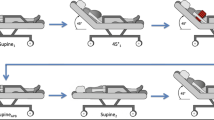Abstract
Objective
To determine the most accurate indirect method of measuring intra-abdominal pressure (IAP) in children.
Design and setting
Single-centre, prospective, clinical study in a 23-bed specialist paediatric intensive care unit in Australia.
Patients and participants
20 children admitted to paediatric intensive care with a peritoneal dialysis catheter in situ following congenital cardiac surgery.
Interventions
IAP was measured directly via the peritoneal dialysis catheter and by intragastric manometry via an indwelling nasogastric tube, and by intravesical manometry via an indwelling transurethral urinary catheter, using volumes of 0, 1, 3 and 5 ml/kg body weight of sterile saline instilled into the bladder.
Measurements and results
Across the range of IAPs of 1–8 mmHg the Bland-Altman method for assessing agreement between two methods of clinical measurement showed bladder pressure measured via the urinary catheter with 1 ml/kg body weight of saline instilled to be the most accurate indirect measurement technique, tending to give pressures between 0.07 and 1.23 mmHg higher than the direct measurement (95% CI for bias). Measuring bladder pressure with either no saline instilled or more saline per kilogram body weight instilled was less accurate over the same range of pressures, as was measuring the gastric pressure.
Conclusions
The most accurate indirect method of measuring IAP in children over the normal range of IAPs involves measuring bladder pressure via a transurethral urinary catheter with 1 ml/kg body weight of sterile saline instilled into the bladder.


Similar content being viewed by others
References
Iberti TJ, Lieber CE, Benjamin E (1989) Determination of intra-abdominal pressure using a transurethral bladder catheter: clinical validation of the technique. Anesthesiology 70:47–50
Fusco MA, Martin RS, Chang MC (2001) Estimation of intra-abdominal pressure by bladder pressure measurement: validity and methodology. J Trauma 50:297–302
Collee GG, Lomax DM, Ferguson C, Hanson GC (1993) Bedside measurement of intra-abdominal pressure (IAP) via an indwelling naso-gastric tube: clinical validation of the technique. Intensive Care Med 19:478–480
Sugrue M, Buist MD, Lee A, Sanchez DJ, Hillman KM (1994) Intra-abdominal pressure measurement using a modified nasogastric tube: description and validation of a new technique. Intensive Care Med 20:588–590
Yaster M, Schere TL, Stone MM, Maxwell LG, Schleien CL, Wetz RC, Buck JR, Nicholls DG, Colombani PM, Dudgeon DL (1989) Prediction of successful primary closure of abdominal wall defects using intraoperative measurements. J Pediatr Surg 24:1217–1220
Greenhalgh DG, Warden GD (1994) The importance of intra-abdominal pressure measurements in burned children. J Trauma 36:685–690
Rizzo A, Davis PC, Hamm CR, Powell RW (1996) Intraoperative vesical pressure measurements as a guide in the closure of abdominal wall defects. Am Surg 62:192–196
Kron IL, Hartman PK, Nolan SP (1984) The measurement of intra-abdominal pressure as a criterion for abdominal re-exploration. Ann Surg 199:28–30
Malbrain MLNG (2004) Different techniques to measure intra-abdominal pressure (IAP): time for a critical re-appraisal. Intensive Care Med 30:357–371
Bland JM, Altman DG (1986) Statistical methods for assessing agreement between two methods of clinical measurement. Lancet I:307–310
Sanchez NC, Tenofshy PL, Dort JM, Shen LY, Helmer SD, Smith RS (2001) What is normal intra-abdominal pressure? Am Surg 67:243–248
Sugrue M, Buist MD, Hourihan F, Deane S, Bauman S, Hillman K (1995) Prospective study of intra-abdominal hypertension and renal function after laparotomy. Br J Surg 82:235–238
Sugrue M, Jones F, Deane SA, Bishop G, Bauman A, Hillman K (1999) Intra-abdominal hypertension is an independent cause of postoperative renal impairment. Arch Surg 134:1082–1085
Bloomfield GL, Ridings PC, Blocher CR, Marmarou A, Sugerman HJ (1997) A proposed relationship between intra-abdominal, intrathoracic and intracranial pressure. Crit Care Med 25:496–503
Rance CH, Singh SJ, Kimble R (2000) Blunt abdominal trauma in children. J Paediatr Child Health 36:2–6
DeCou JM, Abrams RS, Miller RS, Gauderer MW (2000) Abdominal compartment syndrome in children: experience with three cases. J Pediatr Surg 35:840–842
Kirkpatrick AW, Brenneman FD, McLean RF, Rapanos T, Boulanger BR (2000) Is clinical examination an accurate indicator of raised intra-abdominal pressure in critically injured patients? Can J Surg 43:207–211
Wesley JR, Drongowski R, Coran AG (1981) Intragastric pressure measurement: a guide for reduction and closure of the silastic chimney in omphalocoele and gastroschisis. J Pediatr Surg 16:264–270
Biancofiore G, Bindi ML, Romanelli AM, Boldrini A, Consani G, Bisa M, Filipponi F, Vagelli A, Mosca F (2003) Intra-abdominal pressure monitoring in liver transplant recipients: a prospective study. Intensive Care Med 29:30–36
Verbrugghe W, Van Mieghem N, Daelemans R, Lins R, Malbrain MLNG (2003) Estimating the optimal bladder volume for intra-abdominal pressure measurement by bladder pressure-volume curves. Cri Care 7:P184
Davis PJ, Koottayi SV, Taylor A, Butt WW (2004) Comparison of indirect methods of measuring intra-abdominal pressure. Pediatr Crit Care Med 5:312
Acknowledgements
We thank Bendix Carstensen of the Clinical Epidemiology and Biostatistics Unit at the Royal Children’s Hospital for all his help and advice with the statistics related to this study. This study was presented at the 2003 Annual Meeting of the Paediatric Intensive Care Society [21]
Author information
Authors and Affiliations
Corresponding author
Rights and permissions
About this article
Cite this article
Davis, P.J., Koottayi, S., Taylor, A. et al. Comparison of indirect methods of measuring intra-abdominal pressure in children. Intensive Care Med 31, 471–475 (2005). https://doi.org/10.1007/s00134-004-2539-3
Received:
Accepted:
Published:
Issue Date:
DOI: https://doi.org/10.1007/s00134-004-2539-3




